With the growing demands of standardized testing, many schools do not make social-emotional learning (SEL) a priority. Instead of prioritizing acceptance and positive behavior, schools wait to address conflicts until negative behavior occurs. However, in a society where the news is full of hate for one another, teaching young students acceptance is increasingly valuable, especially for students with special needs.
The “Responsive Classroom” (RC) is an approach based on the idea that social-emotional growth and academic achievement are equally as important. There are six components of RC that promote learning through interaction and SEL:
Morning Meeting
The Morning Meeting is the most unique of the six components. The 20 to 30-minute meeting acts as an open forum on respect, trust, empathy, collaboration and self-worth for students and their educator.
Rules and Logical Consequences
RC expresses the importance of logical consequences for breaking rules. Instead of punishing students, logical consequences help students create an internal code and responsibility to follow the rules.
Guided Discovery
As many educators know, classroom supplies can be expensive to replace—a burden that often falls on the educator’s shoulders. Guided discovery helps students responsibly use materials and learn creative and careful ways to use both new and old materials.
Academic Choice
Giving students choices in the classrooms makes for more engaged learners. When a curriculum or particular lesson gives students a choice on how they learn, students see both themselves and their peers are skilled learners – thus further promoting a culture of respect.
Classroom Organization
Students will have issues collaborating if the classroom space is not set up for it. An effective RC includes active areas, displays and a mix of individual, group, and whole-class discussion.
Reaching Out to Parents and Guardians
When educators use multiple channels to communicate with families openly and frequently, parents are more likely to be involved in the education process because they have learned to trust the educator and their teaching methods.
Studies show that RC works. Besides making school a happier environment, students’ scores in reading, math, science and social studies improved when educators implemented all six RC components.
For more information about RC-specific tips for implementation, read this Edutopia blog or visit the RC website for resources.




